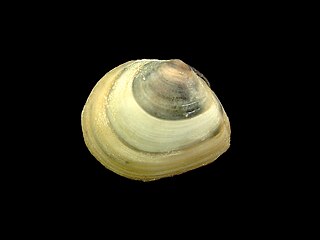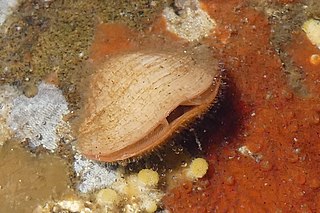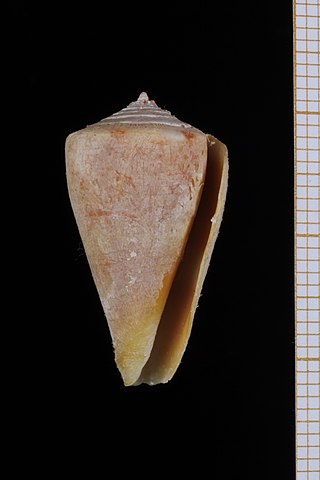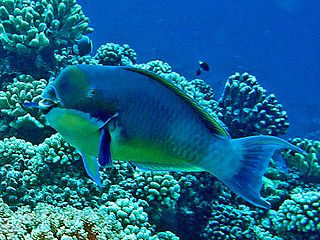
Lingula is a genus of brachiopods within the class Lingulata. Lingula or forms very close in appearance have existed possibly since the Cambrian. Like its relatives, it has two unadorned organo-phosphatic valves and a long fleshy stalk. Lingula lives in burrows in barren sandy coastal seafloor and feeds by filtering detritus from the water. It can be detected by a short row of three openings through which it takes in water (sides) and expels it again (middle).

Monetaria moneta, common name the money cowrie, is a species of small sea snail, a marine gastropod mollusk in the family Cypraeidae, the cowries.

Limecola balthica, commonly called the Baltic macoma, Baltic clam or Baltic tellin, is a small saltwater clam, a marine bivalve mollusk in the family Tellinidae.
Lingula reevii is an inarticulated brachiopod species assigned to the family Lingulidae. L. reevii is rare and is known to occur in shallow, sandy reef flats in Kaneohe Bay, Oahu, Hawaii, as well as in Japan, and Ambon, Indonesia.

Lajonkairia lajonkairii is an edible species of saltwater clam in the family Veneridae, the Venus clams.

Brachiopods, phylum Brachiopoda, are a phylum of trochozoan animals that have hard "valves" (shells) on the upper and lower surfaces, unlike the left and right arrangement in bivalve molluscs. Brachiopod valves are hinged at the rear end, while the front can be opened for feeding or closed for protection. Two major categories are traditionally recognized, articulate and inarticulate brachiopods. The word "articulate" is used to describe the tooth-and-groove structures of the valve-hinge which is present in the articulate group, and absent from the inarticulate group. This is the leading diagnostic skeletal feature, by which the two main groups can be readily distinguished as fossils. Articulate brachiopods have toothed hinges and simple, vertically oriented opening and closing muscles. Conversely, inarticulate brachiopods have weak, untoothed hinges and a more complex system of vertical and oblique (diagonal) muscles used to keep the two valves aligned. In many brachiopods, a stalk-like pedicle projects from an opening near the hinge of one of the valves, known as the pedicle or ventral valve. The pedicle, when present, keeps the animal anchored to the seabed but clear of sediment which would obstruct the opening.

Conus lischkeanus, the Lischke's cone, is a species of predatory sea snail, a marine gastropod mollusk in the family Conidae, the cone snails, cone shells or cones.

Conus ebraeus, common name the black-and-white cone or Hebrew cone, is a species of sea snail, a marine gastropod mollusk in the family Conidae, the cone snails and their allies.

Conus martensi is a species of sea snail, a marine gastropod mollusk in the family Conidae, the cone snails and their allies.

Conus vexillum, common name the vexillum cone or the flag cone, is a species of sea snail, a marine gastropod mollusk in the family Conidae, the cone snails and their allies.

Clavus laetus is a species of sea snail, a marine gastropod mollusk in the family Drilliidae.

Semiricinula squamosa is a species of sea snail, a marine gastropod mollusk in the family Muricidae, the murex snails or rock snails.

Naria poraria, common name the purple-based cowry or porous cowry, is a species of sea snail, a cowry, a marine gastropod mollusk in the family Cypraeidae, the cowries.

Monilea callifera, common name shrewd trochid, is a species of sea snail, a marine gastropod mollusk in the family Trochidae, the top snails.

Gigantoproductus giganteus is an extinct species of brachiopods in the family Monticuliferidae, known only from its fossil remains. It was a marine invertebrate found on the seabed in shallow seas. It evolved during the Carboniferous period and it is believed to be the largest brachiopod that has ever existed.

Swiftopecten swifti, common name Swift's scallop, is a species of bivalve mollusc in the family Pectinidae. It occurs in the northern Pacific Ocean.
Pinctada fucata, the Akoya pearl oyster (阿古屋貝), is a species of marine bivalve mollusk in the family Pteriidae, the pearl oysters. Some authorities classify this oyster as Pinctada fucata martensii. It is native to shallow waters in the Indo-Pacific region and is used in the culture of pearls.

Argyrotheca is a genus of very small to minute lampshells. All species share a large pedicel opening, one ridge on the inside of the pedunculate valve, pits in a diamond pattern on the inside of both valves, and without radial ridges that end in tubercles. It occurs in depths between 6 and 1300 m. It is known since the latest Cretaceous.

Trochus intextus is a species of sea snail, a marine gastropod mollusk in the family Trochidae, the top snails.

Chlorurus microrhinos, the blunt-head parrotfish or steephead parrotfish, is a species of marine ray-finned fish, a parrotfish from the family Scaridae. It is found in the Indo-Pacific region.





















